VW was the small car company. It made Beetles by the bushel that fit in your back pocket, almost. But America super-sized and small cars like the Beetle stopped selling.
So VW stopped selling Beetles – and started selling models like the Atlas, a massive three-row VW SUV big enough to carry a Beetle piggyback, plus seven people.
In 2020, a two-row version of the same thing appeared – the Atlas CrossSport. This one’s big on style, with a lowered roofline, a bit less headroom – and more space for stuff behind its second row.
It’s also a whole lot of VW under its hood – where you’ll find the only V6 you can still get in any new VW . . . excepting its three-row stablemate.
What It Is
A sleeker, two-row-only version of the standard Atlas that’s actually more practical in at least one way than the Atlas.
.
The sleek looks derive from side glass that’s lower and extends farther toward the rear, tapering into a sharper point just before it reaches the more steeply angled rear liftgate. Bright chrome trim plates are also pressed into the bodywork to jazz up the look.
The practical plus derives from the extraction of the third row – making for a roomier second row as well as much more room for cargo behind the second row than the Atlas has behind its third row. 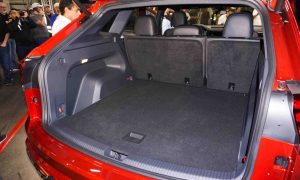
Mechanically, the CrossSport is exactly the same as the Atlas. Both come standard with turbocharged four cylinder engines and can be ordered with VW’s 3.6 liter V6.
Either engine can be paired with FWD or AWD.
Prices start at $30,855 for the base S trim with a 2.0 liter turbocharged four cylinder engine and FWD; adding the optional 4Motion AWD bumps the sticker price up to $32,755.
V6-equipped models start at $37,645 with FWD and $40,095 with AWD.
A top-of-the-line Premium R-lIne with the V6 and AWD lists for $50,025.
What’s New
The ’21 CrossSport offers the latest version of VW’s MIB3 glass-faced/capacitive touchscreen infotainment system, which features wireless App connect and the ability to pair multiple phones.
What’s Good
A VW for buyers who need a big VW – with bigger style.
Available with a big V6.
More cargo room with its seats up than inside the Atlas.
What’s Not So Good
Big price bump to get the V6.
Style costs headroom.
Auto stop/start system is aggressive and intrusive.
Like the standard Atlas, the CrossSport comes standard with what is becoming the Universal Engine in vehicles of all types – a 2.0 liter turbocharged four.
The reason this particular type – and size – engine has become so common in everything from small cars to large crossover SUVs like this VW is because this particular displacement works especially well with turbochargers, which are being used to maintain the power output of smaller engines, which are replacing larger engines without turbos as the car companies struggle to wring more gas mileage out of smaller engines.
More specifically, the relationship of bore-to-stroke ratio and other attributes of a 2.0 liter engine are especially conducive to an agreeable power curve when an engine this size is turbocharged.
Instead of peaky – and revvy – maximum torque is made almost immediately. In this case, all 258 ft.-lbs. are all in at just 1,600 RPM – which is ideal for getting a big VW like this moving without it feeling like the engine is struggling.
Note that the torque produced by the 2.0 liter engine is nearly the same as the torque made by the VW’s optional – and much bigger – 3.6 liter V6, which produces 266 ft.-lbs. not-immediately at 3,500 RPM.
But the V6 has a horsepower advantage. It develops 276 hp at 6,200 RPM while the four is all done at 5,000 RPM – where its maximum of 235 hp is achieved.
What it means is that the 2.0-equipped CrossSport feels stronger in stop-and-go driving, at low and mid-range speeds while the V6-equipped model comes into its own once you’re rolling – where it enjoys revving.
Both engines are paired with eight speed automatics and the same 3.6:1 final drive ratio.
Tow capability varies from just 2,000 lbs. for models with the 2.0 liter engine to 5,000 lbs. for those equipped with the V6.
All CrossSports come with a 19.5 gallon tank, enough fuel to travel more than 450 highway miles – even with the big V6, which almost matches the highway mileage (22 MPG) of the smaller 2.0 liter four (22 MPG).
The smaller engine’s big advantage, MPG-wise, is in city driving – where it rates 21 MPG vs. 16 for the V6-equipped CrossSport.
Aber, there is a caveat.
The four needs premium unleaded to achieve its maximum horsepower and torque; the V6 achieves its maximum horsepower and torque on regular unleaded.
The CrossSport does have one thing in common with the Beetle. It is not a demanding vehicle to drive – unlike many new vehicles, which ought to come standard with a co-pilot to help you manage all the controls.
This one, you just get in – and go.
As in the redoubtable Beetle that made VW one of the world’s biggest-selling brands, you will find pleasantly simple, easy-to-use controls inside the CrossSport – including a grab-handle (rather than mouse/tap/touch) gear-selector that gives feel and feedback and similarly functional rotary knob controls to adjust the temperature/fan and radio station/volume settings. All of which can be adjusted by feel – and so without having to take your eyes off the road.
This is a not just a safety advantage; it is a blood-pressure advantage. It’s less aggravating.
Unfortunately, there is one aggravation that’s worse inside this VW – the repetitive (and intrusive) stop-start cycling of the engine practically every time the vehicle stops. It is especially aggravating when the engine stops when you’ve just parked and you press the ignition off button – and the engine restarts because it shut itself off.
Then you have to press it – again – to get the engine to stop.
Again.
ASS – the actual acronym for Automatic Stop/Start – has got to qualify for the most obnoxious, no-one-asked-for-it but we’re forced to buy it feature since seatbelt interlocks and buzzers back in the ‘70s.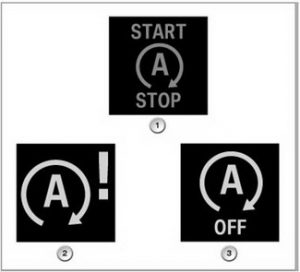
Almost every new vehicle comes with ASS because buyers asked for it but because regulatory pressure – to meet federal fuel efficiency mandates – effectively requires it.
But the trivial fuel savings (about 1 MPG overall) achieved by cycling the engine off and on a dozen times or more each trip is far outweighed by the cost imposed on your peace of mind.
Also, very likely, the cost of having to replace the starter battery more often due to all that restarting.
The good new is ASS is defeatable – and not just by remembering to push the “off” button every time you go for a drive. You can program it to stay off, forever. It’s perfectly legal and will cause no harm to the vehicle or your warranty coverage.
ASS aside, the CrossSport is an extremely agreeable big lug – in spite of of its bigness, which is why it’s so agreeable. It doesn’t feel oafish or monstrous. Light steering and good visibility make close-quarters maneuvering easy, so long as it’ll fit into the spot you’re angling into.
Both engines have their merits. The four is probably the best choice for the mostly-city driving owner; the V6 is the better choice for high-speed highway work.
It’s nice, as an aside, that VW doesn’t force you to buy the V6 to get the available 4Motion AWD system.
And both the FWD and AWD models have eight inches of ground clearance – more than most crossovers, especially the FWD ones.
The CrossSport puts form ahead of function vs. the standard Atlas. It seats only five vs. seven and there’s less headroom – 37.8 inches vs. 40.4 – for the three of those five,the ones who sit in the Crosstrek’s backseats.
But the stats are not necessarily functionally meaningful unless your “roofline” is much higher than average. A man well over six-feet tall (me) can sit in the Crosstrek’s second row without his head getting polished by the headliner. For normal-sized adults, it’s even less an issue.
Legroom might be more of an issue – for the standard Atlas, which only has 37.6 inches vs. a much more generous 40.4 inches for the CrossSport. This is the boon of dispensing with the third row, which opens up more floorspace.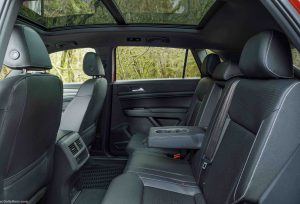
There is more cargo space, too – behind the CrossSport’s second row: 40.3 cubic feet vs. only 20.3 cubic feet behind the standard Atlas’s third row. The standard Atlas does boast more total cargo space – 96.8 cubic feet with both its second and third rows folded.
But you have to fold them to get more space for cargo than you have available in the CrossSport with its second row in use.
With the second row down, cargo space opens up to 77.8 cubic feet.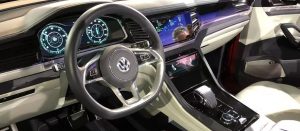
There is something else besides the numbers to take into account when considering the CrossSport relative to other large crossovers in its price range like the Chevy Blazer, Ford Edge and Honda Passport. It is the only crossover in its price range that’s closely related to much more pricey luxury crossovers – from Audi, which is part of the VW family.
It is reasonable to cross-shop the CrossSport vs. an Audi Q5 – which is smaller and comes standard with essentially the same 2.0 liter engine (marginally stronger, rated as making 248 hp) and starts at $43,300.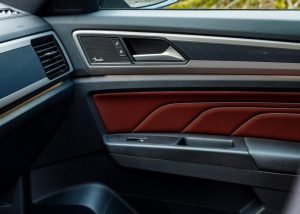
Especially when you compare that with a loaded CrossSport with the V6, the optional digital cockpit – and LCD flatscreen gauge cluster – plus the available 900 lumen LED headlights, 480 watt, 12-speaker Fender audio rig, the huge (4.5 feet long) sunroof and available 21-inch wheel/tire package.
Sit inside both and see for yourself. The VW looks expensive.
The Audi is.
The Rest
VW’s touchscreen has a glass rather than plastic face and you can work it without tapping it. The glass is as pinch/swipe sensitive as the glass facing of your smartphone and has the additional advantage of being better-looking. Plastic looks cheap – especially as it ages.
Glass is classy – and never hazes over.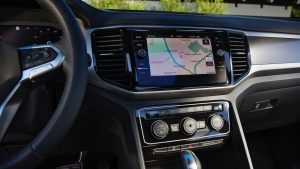
VW’s MIB3 interface is voice-commandable and you can even command the car to do things like honk the horn or flash the lights or open the door when you’re not in or even near the car via Car-Net Remote Access.
VW also offers something called Speed Alert – an app that notifies the owner when someone else is driving it faster than a predetermined maximum speed set by the owner. The idea here being, apparently, to keep teenaged drivers from hot-shoeing the family sled. But it’s also an app that could be used to narc out the owner to the insurance mafia – or the government – from driving faster than either of them like.
This is already there, too. VW offers something called DriveView, which enables the insurance mafia to know exactly how fast you drive – and brake – as when and how far you drive. For now, it’s voluntary enrollment. 
One day it may not be.
Keep in mind that car companies are claiming they own the data emitted by your car – which kind of makes it not really your car.
The Bottom Line
The CrossSport is prettier – and in some ways more practical – than its three-row stablemate.
And that’s no small thing!
. . .
Got a question about cars, Libertarian politics – or anything else? Click on the “ask Eric” link and send ’em in!
If you like what you’ve found here please consider supporting EPautos.
We depend on you to keep the wheels turning!
Our donate button is here.
If you prefer not to use PayPal, our mailing address is:
EPautos
721 Hummingbird Lane SE
Copper Hill, VA 24079
PS: Get an EPautos magnet or sticker or coaster in return for a $20 or more one-time donation or a $10 or more monthly recurring donation. (Please be sure to tell us you want a magnet or sticker or coaster – and also, provide an address, so we know where to mail the thing!)
If you’d like an ear tag – custom made! – just ask and it will be delivered.
My latest eBook is also available for your favorite price – free! Click here. If that fails, email me at [email protected] and I will send you a copy directly!




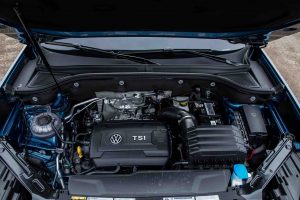
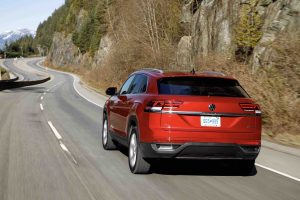
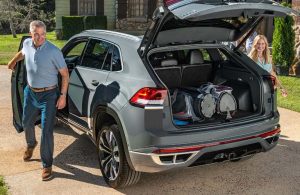







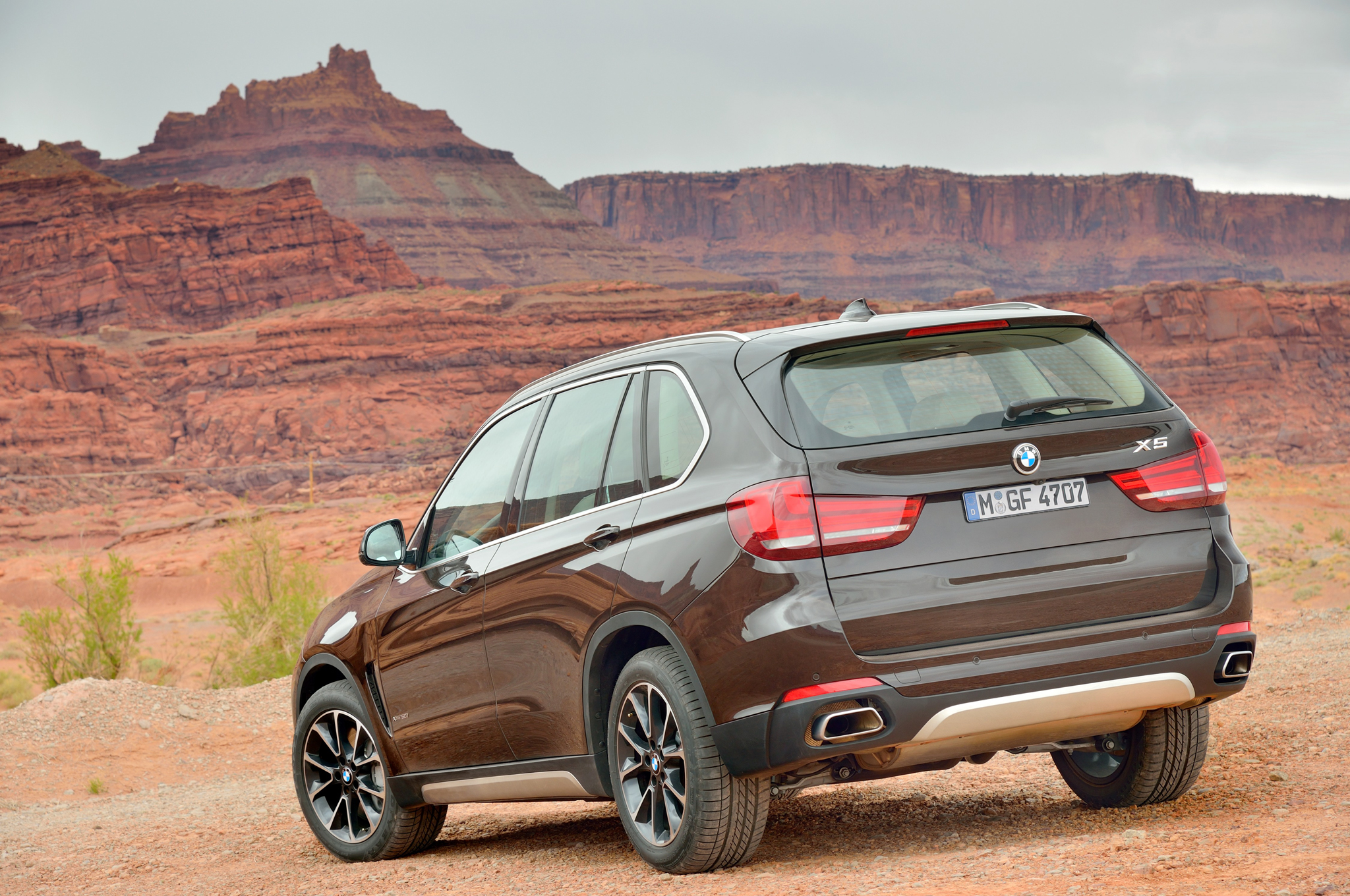
How about another funny news item?
In Milwaukee(a native name that must be expunged) the recently retired county executive was an attempted car hijack. The carjackers at gunpoint attempted to steal the car, but it is a manual. They got so frustrated that they put two bullets in the car and left for most of everything out there.
I think that the insurance companies should give a lower premium for manual gearboxes.
Morning, Erie!
There is much truth to this – that a manual transmission deters thieves – and not just because so many Millennials never learned to operate one. It’s also because it’s harder to offload a stolen vehicle so few know how to drive!
I hate any new car even if it has large cargo space. With small cargo space the wife would not be able to buy and carry useless offal.
I hate the electronics that will leave one at the side of the road. My buy was a 2011 CTS-V. It crapped out from the computer not signalling from a damned clutch sensor. It has no oil pressure indication because that is more electrics. All of the luxury crap is in unintelligible hieroglyphs.
The pisser is that it runs well and fast when needed but is crippled by the electrics..
I do hate the stupid thing where one walks past of the car and it unlocks. Speaking of locks, who was the dimwit that put in the dopey coffin without a handle to get out?
It is though the platform guys delivered their creation to a committee of masters in marketing degrees to make it 20,000 more than Cadillac was trying to attract.
Those that designed and built the platform have my sympathy. The upper management and mions that ruined it have my contempt.
Oh, I forgot to add that I hate the goomint. Wear a mask and do the safe distance thing.
I don’t understand the attraction of these “Coupe-U-Vees”. It has to be purely styling, as the sloping roof makes it impossible to carry anything boxy, like a television (flat panel TVs should be transported vertically).
I’ve sat in an Atlas, and VW has finally figured out how to build an SUV that Americans will buy. I see them everywhere.
Hi Chip,
I think I understand the attraction; it’s simply a matter of driving something that doesn’t look like everyone else’s appliance. I can attest – having driven both versions of the Atlas – that the CrossSport could take a flat panel TV vertically…in the second row. Possibly also nearly so in the rear,if you set it slightly angled and front to back.
Not everyone needs a third row but many want the second row room – and cargo room – of something Atlas-sized. And thus, the CrossSport!
I think my dislike of that body style dates back to when I had the 1st gen CR-V. I had bought a tube HDTV (a huge box!) that fit in the cargo area with a couple of inches to spare, because the rear glass was vertical. I couldn’t do that with a Coupe-U-Vee because of their sloping glass.
But since the days of tube CRTs are long gone, maybe I shouldn’t be so negative about them since the probability of needing that space is pretty darn low. As long as the rifle case can fit back there I’m fine. 🙂
Indeed, Chip!
The CrossSport will take a large load of awkwardly-sized stuff. I know because I filled one with awkwardly sizes stuff – a friend’s stuff, helping her move. I get the appeal of these things though I would personally rather have a full-size station wagon myself, V8 and RWD!
I prefer this model over the standard Atlas, purely from a superficial standpoint. I saw one of these for the first time a few weeks ago and wondered what that thing was we just passed; “Was that an Atlas?” Didn’t care enough to look it up then, but I like what VW designers did. We used to own a Touareg, which is a little more athletic and sporty looking, so the CrossSport is closer to what I like.
I would never, never buy a vehicle that had stop/start you couldn’t turn off. Hate it! I want my engine running, all the time, especially when making a left turn.
Reminds me of my 2006 Pontiac stationwagon that would randomly Stop anywhere when your foot was off the gas. De-dumpty dump – engine dead – not a good feeling!
1986 Pontiac 6000 stationwagon, 🙄 – I’m getting old
Hi Snap,
I prefer the CrossSport myself for the styling – and because I don’t need a third row but can use the increased cargo space behind the second row.
This thing would be much better, though, with a TDI V6…. sigh…
VW still makes excellent sedans. I might consider a 2018 passat. Low key – excellent visibility – and I believe without the ASS stuff. With officer friendlies around keeping it boring helps